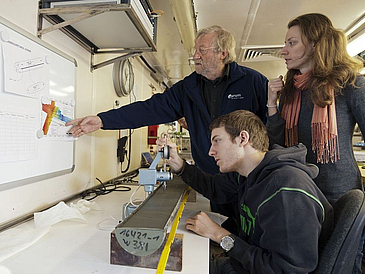At a press conference held in Vienna, Prof. Gerold Wefer, University of Bremen, and Michael Strasser, ETH Zürich, presented some initial results of their expedition on board the research vessel SONNE off the coast of Japan. The voyage, which was also joined by other researchers from Japan and Switzerland, took place from 8th March till 6th April 2012. The objective was to find out whether the major Tohoku earthquake that struck on 11th March 2011 had left any traces on the ocean floor. It turns out that the mega earthquake that triggered the devastating Tsunami a little over a year ago stirred up and displaced large amounts of sediment. Moreover, sediment samples taken from a depth of 7,700 meters reveal evidence of other mega earthquakes which occurred in the Earth’s past history.
Leader of the expedition, which was funded by the German Ministry of Education and Research and the German Research Society, DFG, was Prof. Gerold Wefer, Director of the MARUM Center for Marine Environmental Sciences at the University of Bremen. The team, which numbered 33 all told, investigated regions of the ocean at the epicenter of the big quake. Japanese researchers located the epicenter at a depth of 32 kilometers some 70 kilometers off the coast of the largest Japanese island, Honshu.
Despite high winds and heavy seas, the MARUM-QUEST underwater robot was able to go down to two Japanese deep-sea observatories at a depth of approx. 2,700 meters. “It then became clear that the earthquake had moved one of the two observatories a little to the South East”, says the expedition’s leader, Gerold Wefer. Measurements taken by the Japanese researchers also reveal that part of the earth’s crust in the proximity of the Japanese deep-sea trench had been shifted some 50 meters by the earthquake and some areas off the coast around Honshu by up to five meters to the East.
Specially devised echo-sounders on the ocean floor confirmed these data for the epicenter. Data comparisons with ocean charts mapped for the same region by Japanese researchers back in 1999 and 2004 show that there has been no shift farther north or south. “The movements of the Earth’s crust seem to have been restricted to a relatively small area”, Wefer explains.
On a second stretch covered by the expedition, the SONNE team collected samples from the ocean floor. With the aid of a gravity corer, a sort of hollow cylinder, they brought a total of 95 meters of sediment core 12 centimeters in diameter to the surface. The samples were taken from depths of about 1,350 to 7,550 meters, both from the shallow coastal waters as well as from the depths of the deep-sea trench.
Prof.Michael Strasser, a geologist from the Eidgenössisch-Technischen Hochschule Zürich (ETHZ), conducted the first examinations on the sediment samples in SONNE’s geo-laboratory. He found that the quake had triggered underwater avalanches, causing huge amounts of sediment to relocate. During his still ongoing investigations, the ex-MARUM researcher came across evidence of three other mega earthquakes which had taken place much earlier in history. “Further analysis in our base laboratory will show just how big these were and precisely when they happened”, says Strasser. “Not until then will we hopefully be able to calculate just how often large earthquakes like the one last year are likely to occur”.
For further information/graphic material/interview requests pleas contact:
Universität Bremen
MARUM Public Relations
Albert Gerdes
Phone: +49 - 172 – 43 77 986
Email: agerdesprotect me ?!marumprotect me ?!.de
www.marum.de

